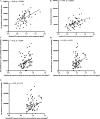Accumulation of Black Carbon Particles in Placenta, Cord Blood, and Childhood Urine in Association with the Intestinal Microbiome Diversity and Composition in Four- to Six-Year-Old Children in the ENVIR ON AGE Birth Cohort
- PMID: 36719212
- PMCID: PMC9888258
- DOI: 10.1289/EHP11257
Accumulation of Black Carbon Particles in Placenta, Cord Blood, and Childhood Urine in Association with the Intestinal Microbiome Diversity and Composition in Four- to Six-Year-Old Children in the ENVIR ON AGE Birth Cohort
Abstract
Background: The gut microbiome plays an essential role in human health. Despite the link between air pollution exposure and various diseases, its association with the gut microbiome during susceptible life periods remains scarce.
Objectives: In this study, we examined the association between black carbon particles quantified in prenatal and postnatal biological matrices and bacterial richness and diversity measures, and bacterial families.
Methods: A total of 85 stool samples were collected from 4- to 6-y-old children enrolled in the ENVIRonmental influence ON early AGEing birth cohort. We performed 16S rRNA gene sequencing to calculate bacterial richness and diversity indices (Chao1 richness, Shannon diversity, and Simpson diversity) and the relative abundance of bacterial families. Black carbon particles were quantified via white light generation under femtosecond pulsed laser illumination in placental tissue and cord blood, employed as prenatal exposure biomarkers, and in urine, used as a post-natal exposure biomarker. We used robust multivariable-adjusted linear models to examine the associations between quantified black carbon loads and measures of richness (Chao1 index) and diversity (Shannon and Simpson indices), adjusting for parity, season of delivery, sequencing batch, age, sex, weight and height of the child, and maternal education. Additionally, we performed a differential relative abundance analysis of bacterial families with a correction for sampling fraction bias. Results are expressed as percentage difference for a doubling in black carbon loads with 95% confidence interval (CI).
Results: Two diversity indices were negatively associated with placental black carbon [Shannon: (95% CI: , ); Simpson: (95% CI: , )], cord blood black carbon [Shannon: (95% CI: , ); Simpson: (95% CI: , )], and urinary black carbon [Shannon: (95% CI: , ); Simpson: (95% CI: , )]. The explained variance of black carbon on the above indices varied from 6.1% to 16.6%. No statistically significant associations were found between black carbon load and the Chao1 richness index. After multiple testing correction, placental black carbon was negatively associated with relative abundance of the bacterial families Defluviitaleaceae and Marinifilaceae, and urinary black carbon with Christensenellaceae and Coriobacteriaceae; associations with cord blood black carbon were not statistically significant after correction.
Conclusion: Black carbon particles quantified in prenatal and postnatal biological matrices were associated with the composition and diversity of the childhood intestinal microbiome. These findings address the influential role of exposure to air pollution during pregnancy and early life in human health. https://doi.org/10.1289/EHP11257.
Figures






Comment in
-
Inside Information: Black Carbon Exposure and the Early-Childhood Gut Microbiome.Environ Health Perspect. 2023 Apr;131(4):44001. doi: 10.1289/EHP12829. Epub 2023 Apr 14. Environ Health Perspect. 2023. PMID: 37058434 Free PMC article.
Similar articles
-
Sex differences in the association between long-term ambient particulate air pollution and the intestinal microbiome composition of children.Environ Int. 2025 May;199:109457. doi: 10.1016/j.envint.2025.109457. Epub 2025 Apr 12. Environ Int. 2025. PMID: 40273556 Free PMC article.
-
Association of Insulin Resistance and Type 2 Diabetes With Gut Microbial Diversity: A Microbiome-Wide Analysis From Population Studies.JAMA Netw Open. 2021 Jul 1;4(7):e2118811. doi: 10.1001/jamanetworkopen.2021.18811. JAMA Netw Open. 2021. PMID: 34323983 Free PMC article.
-
Associations of Childhood and Perinatal Blood Metals with Children's Gut Microbiomes in a Canadian Gestation Cohort.Environ Health Perspect. 2022 Jan;130(1):17007. doi: 10.1289/EHP9674. Epub 2022 Jan 17. Environ Health Perspect. 2022. PMID: 35037767 Free PMC article.
-
Association between antibiotics and gut microbiome dysbiosis in children: systematic review and meta-analysis.Gut Microbes. 2021 Jan-Dec;13(1):1-18. doi: 10.1080/19490976.2020.1870402. Gut Microbes. 2021. PMID: 33651651 Free PMC article.
-
Gut dysbiosis in rheumatic diseases: A systematic review and meta-analysis of 92 observational studies.EBioMedicine. 2022 Jun;80:104055. doi: 10.1016/j.ebiom.2022.104055. Epub 2022 May 17. EBioMedicine. 2022. PMID: 35594658 Free PMC article.
Cited by
-
Translocation of black carbon particles to human intestinal tissue.EBioMedicine. 2024 Dec;110:105464. doi: 10.1016/j.ebiom.2024.105464. Epub 2024 Nov 23. EBioMedicine. 2024. PMID: 39580969 Free PMC article.
-
The relationship between prenatal drought exposure and the diversity and composition of gut microbiome in pregnant women and neonates.Sci Rep. 2025 Jan 2;15(1):296. doi: 10.1038/s41598-024-82148-6. Sci Rep. 2025. PMID: 39747960 Free PMC article.
-
Pathways to the Brain: Impact of Fine Particulate Matter Components on the Central Nervous System.Antioxidants (Basel). 2025 Jun 14;14(6):730. doi: 10.3390/antiox14060730. Antioxidants (Basel). 2025. PMID: 40563362 Free PMC article. Review.
-
Altered Gut Microbiota Composition Is Associated with Difficulty in Explicit Emotion Regulation in Young Children.Microorganisms. 2023 Sep 6;11(9):2245. doi: 10.3390/microorganisms11092245. Microorganisms. 2023. PMID: 37764088 Free PMC article.
-
Inside Information: Black Carbon Exposure and the Early-Childhood Gut Microbiome.Environ Health Perspect. 2023 Apr;131(4):44001. doi: 10.1289/EHP12829. Epub 2023 Apr 14. Environ Health Perspect. 2023. PMID: 37058434 Free PMC article.
References
-
- European Union. 2008. Directive 2008/50/EC of the European Parliament and of the Council of 21 May 2008 on Ambient Air Quality and Cleaner Air for Europe, 169–212. https://eur-lex.europa.eu/legal-content/EN/TXT/HTML/?uri=CELEX:32008L005... [accessed 22 October 2021].
Publication types
MeSH terms
Substances
LinkOut - more resources
Full Text Sources
Miscellaneous

